Introductory Hebrew Books for Children (Page 3) |
If you wish to purchase any of these books, click on either the title or the book cover to be directed to Amazon.com. As a warning, I have put up pictures of the book covers to give you somewhat an idea of the style of each book (I know, I know. "Don't judge a book by its cover") so the pages may load slowly, depending on the speed of your internet connection.
If this page came up without frames, Click here to see the complete website
Other Pages of Interest:
Introductory Hebrew Books
Page 1 |
Page 2 |
Page 3 |
Page 4
Easy Reader and Picture Books:
Jewish Children's Books (General) |
Jewish Board Books |
Biblical Stories for Children |
Jewish Holiday Books |
Jewish Family Cookbooks |
Folktales and Talmudic Stories for Children |
Jewish Life Books (Mitzvot, Keeping Kosher, etc.) |
Jewish Life Cycle Books |
Family Haggadahs |
Children's Prayerbooks |
Introductory Hebrew Books |
Jewish History and Historical Fiction Picture Books |
Israel Books
Middle School and YA Books:
Bar Mitzvah Books |
Jewish Fiction |
Historical Fiction |
Torah Study |
Prayer and Jewish Life Books |
Jewish Holidays |
Jewish Biographies |
Jewish History Books |
Holocaust Books for Teens |
Israel Books
Jewish Books for Children |
Bar Mitzvah Books |
Jewish Parenting Books |
Jewish Music for Children |
Jewish Videos |
Jewish Toys and Gifts |
Jewish Gift Baskets and Gourmet Food |
Jewish Jewelry |
Amazon.com Coupons, Promotions, and Sales

Shirim K'Tanim-Hebrew Song Fest
(VHS Video)
With a wink here and a jig there genial Israeli TV star Uzi Chitman takes toddlers and young children on a musical tour of over 40 of Israel's best-loved children's songs. Accompanied by a handful of Israeli boys and girls, the singer/guitarist cavorts against a backdrop of colorful, simply sketched scenes depicted in each song.
Line dances and clapping games liven the action and little ones will join in the pantomime of songs like "Lakova Sheli" (My Hat Has...) or "Etsba'ot Li" (I Have Fingers). They'll also laugh at hearing their own favorites like "Old McDonald" sung with a Hebrew twist when Chitman and his chaverim (pals) visit the farm of "Dod (Uncle) Moshe." Adults can help the kids keep up with this fast-paced collection by reading the translations and transliterations that accompany most songs.
Description from Publisher
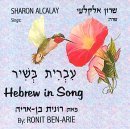
Hebrew in Song
By Ronit Ben-Arie & Sharon Alcalay
(CD)
Song List:
- Amen V'amen
- Shana Tova
- Yerushalayim
- B'yachad Im Yisrael
- Shabbat Hamalka
- Birkat Shalom
- Shir Hahoraot
- Bakita Sheli
- Arba'at Haminim
- Chagiga Bagan
- Shir Ha'etz
- Shir Haperot
- Ma Basalat?
- Stav
- Choref
- Bigday Choref
- Aviv
- Bakayitz
- Tzva-im Li
- Kos Kiddush
- Zman Lishon
Hebrew in Song is a collection of 21 original songs composed by Ronit Ben-Arie; a teacher, composer and arts therapist, who specializes in teaching Hebrew through the arts . These songs are in Hebrew and English and introduce children to simple Hebrew words and phrases as a way to teach Hebrew vocabulary and grammar as well as provide information about Jewish celebrations and customs and the Jewish year. "Hebrew in Song" can be used to generate activities in movement, drama, educational games and art projects. The songs relate directly to topics from the child's life. Topics include Shabbat and holidays, custom greetings and activity directions, fruit, vegetables, colors, seasons, clothing and objects. The songs were written to be used in class, at home and at community celebrations.
The CD features 21 songs at highest quality of recording, highly professional vocals and a variety of mostly live instruments orchestrated together. A 12-page booklet is included with the CD. The booklet contains the lyrics of the songs in Hebrew and transliteration in English.
Album Description
Searching for a fun way to teach Hebrew in the classroom and at home to young families? We have just what you're looking for, as we proudly introduce educator, composer, songwriter and Expressive Arts Therapist Ronit Ben-Arie and her playful new recording and songbook. A charismatic collection of 21 original children's songs especially designed to familiarize young people with the Jewish holidays and basic vocabulary words teaching about "…fruit, vegetables, colors, seasons, winter clothing and objects." The music comes to life with the beautiful vocal interpretations of Sharon Alcalay Leibovici, Lisa Segal, and Shelly Orbach. Songbook complete with Teacher's Guide including sheet music, transliteration of the lyrics, Hebrew text, as well as a dictionary of key words. Suggested educational activities also enclosed. Liven up the classroom with Bakita Sheli, Chagiga Bagan, Ma Basalat, Amen V'amen, B'yachad Im Yisrael, Yerushalayim, Kos Kiddush, and many more!

Renyi Picture Dictionary Hebrew
By P. Renyi
Hebrew: A Language Course
By Ora Band
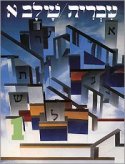
Level One
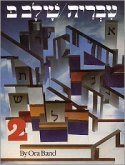
Level Two

Level Three
This three-volume course is the ideal Hebrew program for English-speaking high school, college, and adult education students. The only entry requirement is the ability to recognize Hebrew letters and to read basic words. This course requires only one or two hours of class time each week. Features include:
- Varied reading selections that range from contemporary stories to Hasidic tales, midrashim, and biblical narratives
- Lessons that train students to read confidently both with and without vowels
- Grammatical concepts explored through comparison to English structure
Description from Publisher
I used this book when I was a kid and thought that it was the best Hebrew book that I had. I am now using it to teach my own students. It is a very great book because it does not assume that you have outside knowledge. The texts build on each other like you would hope that a language text would. The series is aimed at adults however I would recommend it for any age group.
This book assumes that students aren't in an ulpan or other immersive environment, which is good because I'm not and most American students aren't. It takes it slowly with lots of exercises. The other thing I really like about this series is that it uses examples from Jewish culture, the Bible and other Jewish writings. It goes beyond teaching language to teach culture.
Ora Band and Bella Bergman have shattered the rules of Hebrew instruction with this ground breaking work. The "Shelabim," in the vernacular, works with all sides of the brain to ensure total absorption of grammar, language and usage. One can use this text for young and older adults, teens and younger kids with equal ease. Students will come away from this work really having learned something. I used this text on a college level, and the students learned a great deal without feeling they had overly exerted themselves.
I was Bar Mitzvah 37 years ago and had not studied since then. I wanted to be able to speak Hebrew, and to understand the Siddur. Studying with a tutor and using this book was a terrific start. It is entertaining and warm. While you learn, the stories in each unit will heighten your mood. Then you can go ahead to Level 2, and it get's better. I doubt that there is any better way to learn Hebrew for one who vaguely remembered the aleph-bet.
Descriptions from Amazon.com Customer Reviews
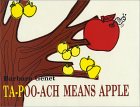
Ta-Poo-Ach Means Apple
Captioned illustrations introduce the letters of the Hebrew
alphabet and common Hebrew words, from ta-poo-ach
(apple) to ra-keh-vet (train)
Description from Publisher
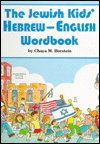
The Jewish Kids' Hebrew-English Wordbook
Here are the Hebrew words a Jewish kid needs to know...a book full of useful
Hebrew words and phrases. This book offers kids a new and enjoyable way
to learn Hebrew. Using full-color illustrations of such familiar scenes as a
summer camp, a synagogue, a kibbutz, and an Israeli town, award-winning
author Chaya Burstein takes children on a fun-filled tour of familiar American
and Israeli settings, teaching them about the Jewish holidays and customs.
Since each word is highlighted in English and Hebrew, with Hebrew
transliterations, it's easy for young readers to recognize and absorb each new
word. In addition, children will love searching for Kofee, the playful monkey,
who hides within each page. The Jewish Kids' Hebrew-English Wordbook
is great at home, where kids and their parents can learn together, or in the classroom.
Description from Publisher

My First Hebrew Alphabet Book
By Jennifer Lapine and Susan Lapine
The perfect aleph-bet for ages three through seven. Big Hebrew
letters with English pronunciations are faced by sprightly
pictures of animals and objects illustrating their use. A
visual adventure!
Description from Publisher
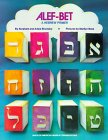
Alef Bet :
A Hebrew Primer
By Abraham and Adaia Shumsky
A phonetic approach,
Alef-Bet systematically introduces the letters and vowels of the
Hebrew alphabet, then words used in blessings, prayers, and discussions
of Jewish symbols, customs, and holidays. Includes photographs of
three-dimensional cutouts in full color.
Description from Publisher
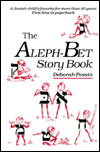
The Aleph-Bet Story Book
A JPS children's classic. These appealing stories bring life
and character to several letters of the Hebrew alphabet. Do
you know how Dalet helped Adam build his home? Do
you know how Vav assisted in the Exodus from Egypt?
Description from Publisher
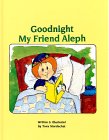
Goodnight My Friend Aleph
By Tova Mordechai
A charming, delightfully illustrated book, designed to
lull your little one to sleep while teaching
Aleph- "Basics." As he says "goodnight" to all of his
friends - from Eliezer Avraham Esrog to Tanchum
Torah - he is introduced to the essential objects
in a Jewish child's life. Contains a glossary and
the "Shema" in Hebrew and English.
Description from Publisher

Perah Ha Shalom (Peace Flower, in Hebrew)
By Ada Aharoni
Peace Flower is a beautiful and inspiring story for the entire family, which can be read from the age of ten to a hundred and ten. It will delight young and old both for its exciting story, and its deep levels of symbolic and metaphorical truths relevant to our own times. It is an imaginative tale of fantastic adventures in space, to find the Peace Flower and bring it back to earth as it does not yet exist in our present.
Lee and Ronni, two brave children, face the terrible nuclear giant Nuki, who tries to stop them from bringing the magical peace flower to our earth.
If they do, they will have the opportunity to put the symbolic nuclear dragon, Nuki, back into its box and end war forever. They travel the universe, past, present and future in a magical vehicle called, Muzi, guided by Petra, the smart and resourceful sister of Peter Pan.
When Lee and Roni, at the suggestion of wise scientist Bayles, go on their dangerous and urgent mission to find the Peace Flower, which can only be found in Esperia, the Land of the Future, they symbolize our hope that the next generation will be able to create a better world beyond war.
Description from Publisher
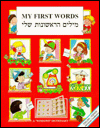
My First Words

Renyi Picture Dictionary :
Hebrew and English

The Yiddish Alphabet Book
Introduces the twenty-two basic letters of the Yiddish alphabet and words that demonstrate each letter's sound.
Description from Publisher
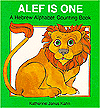
Alef is One:
A Hebrew Alphabet and Counting Book
By Katherine Janus Kahn
From ONE (Alef) bright orange lion to 400 (Taf) rainbow-colored parrots,
this bestiary is sure to delight. With transliterations.
Description from Publisher

Let's Read Hebrew:
The Aleph Bet for Our Days
By Anna Parmet Koch

The New Siddur Program for Hebrew and Heritage:
Reading Readiness Book
By Carol Levy
An introduction to the alef bet at the pre-primer level. Pictures from our Jewish heritage illustrate each Hebrew letter, including:
- Bayit for bet
- Torah for tav
- Shofar for shin
- Melech for mem
102 colorful images teach the name of each letter and the sound it makes, while presenting a picture dictionary of practical vocabulary for beginning Hebrew students. Print writing practice reinforces the form of the letter. Visual and auditory discrimination exercises drill letter recognition.
Reading Readiness is the ideal introduction to
The New Siddur Program Primer.
Description from Publisher
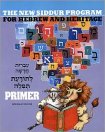
The New Siddur Program for Hebrew and Heritage:
Primer
By Pearl Tarnor and Ruby G. Strauss
Each lesson--40 in all--focuses exclusively on a single letter or vowel, colorfully illustrating its sound and form. For example, the letter mem is introduced with mezuzah; het, with hallah.
- Look-alike letters are presented separately
- Phonetic Hebrew reading exercises are built exclusively on siddur words and word fragments
- Each lesson builds on prior lessons, providing automatic reinforcement and developing siddur reading skills quickly and easily
- Selected siddur words are presented with English translations, paving the way for prayer comprehension
In every chapter, students build upon what they've already learned. By the end of the book, students can read Hebrew--and they will have been introduced to over 200 prayer words.
Description from Publisher

The New Siddur Program for Hebrew and Heritage:
L'Hamshich: A Transitional Text
This transitional text builds a bridge from the Primer to Book 1 of The New Siddur Program. It provides reading review, remediation, and vocabulary readiness, geared to prepare for Book 1.
Description from Publisher
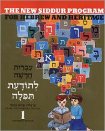
The New Siddur Program for Hebrew and Heritage:
Book One
By Pearl and Norman Tarnor
Your students already have a basic prayer vocabulary. Now they're ready to build a strong foundation for siddur study with a unique, lively combination of prayer materials, activities, and stories.
- Builds knowledge progressively, beginning with the simplest and most common grammatical structures
- Prayer excerpts present siddur vocabulary in its proper liturgical context
- Reading practice of key prayers builds siddur fluency, while developing an understanding of the underlying Jewish values
- Activities facilitate translation and comprehension of key siddur words
- Stories with contemporary themes introduce siddur vocabulary in a modern Hebrew context
- Checkpoints monitor student progress to ensure success
- Bring the language of Hebrew prayer to life in your classroom.
Description from Publisher
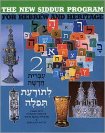
The New Siddur Program for Hebrew and Heritage:
Book Two
By Pearl and Norman Tarnor
Students build on the skills they learned in Book 1 and continue on the path to siddur Hebrew mastery, with extra attention paid to comprehension of prayer words and concepts.
- Fluent Prayer Reading--consistent prayer-reading practice builds siddur fluency
- Prayer Readiness--conceptual introductions motivate students and enliven prayer reading
- Prayer Practice--prayer excerpts reinforce siddur vocabulary
- Written Prayer Exercises--drills common prayer words and siddur translation
- Illustrative Stories--present siddur vocabulary in contemporary settings
- Continuous Reinforcement--each lesson builds on prior lessons, providing automatic review
- Checkpoints--students' progress is measured throughout
Students are on their way to fluency.
Description from Publisher
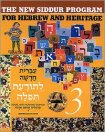
The New Siddur Program for Hebrew and Heritage:
Book Three
By Pearl and Norman Tarnor
The unique format of Book 3 recognizes students' ability to work more directly and actively with prayer material than ever before.
Each lesson begins with a prayer. Reading exercises continue to promote siddur fluency, while grammar exercises bolster vocabulary comprehension with a strong emphasis on roots, suffixes, and prefixes. Each lesson concludes with a traditional story that illustrates the theme of the prayer. Stories include:
- Why did King Solomon build the Holy Temple in Jerusalem?
- How did Rabbi Hillel show his love for God through Torah study?
- Why did Rabbi Akiba study Torah in the face of great personal danger?
- How did Rabbi Joshua teach a Roman king that there is only one God?
Upon completing Book 3, students will have achieved basic prayer literacy. They will have learned all of the prayers in the Shabbat Morning Service, selections from the Friday Evening Service, and blessings recited at home.
Description from Publisher
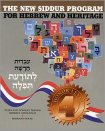
The New Siddur Program for Hebrew and Heritage:
Book Four
By Pearl and Norman Tarnor
For schools requiring an additional year of study in The New Siddur Program, Book 4 builds upon the basic prayer literary students have already achieved. Their mastery of the Shabbat service is extended to the prayers we recite on the High Holidays and Passover. Readings from the Mahzor and the Haggadah introduce holiday concepts and key vocabulary.
Book 4 is divided into two units: the first presents selections from the High Holiday Mahzor; the second is built around the Passover Haggadah. Each chapter contains:
- A prayer presented along with a conceptual introduction
- A vocabulary list divided into words the students already know and new words introduced in the chapter
- Exercises to reinforce key vocabulary and grammatical structures
- A concluding story illustrating the theme of the lesson's prayer
- A traditional Hebrew saying to draw focus to the ethical values of our prayers
Students broaden their Hebrew mastery.
Description from Publisher
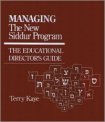
The Educational Director's Guide to Managing the New Siddur Program
By Terry Kaye
A comprehensive, hands-on guide to managing the best-selling Hebrew program in North America. Use this management guide to:
- Customize The New Siddur Program for your school.
You will want to adapt The New Siddur Program to fit your specific needs. Discover practical techniques for personalizing the program, including sample classroom sessions to help teachers complete each book in just the right amount of time.
-
Assess student progress in the program.
Managing The New Siddur Program includes a test for every prayer in the series, providing the educator with a road map of what the students should learn in each chapter while evaluating progress in key areas like grammatical structure, vocabulary, and prayer concepts.
-
Support and motivate your teachers.
Give your teachers the tools they need for effective classroom instruction, including games to enliven the classroom, a management formula to help teachers finish the textbook on time, tips on each chapter's most important points, and suggestions on how to get the most out of the Teacher's Editions.
-
Acquaint parents and school board members with your Hebrew program.
All the information you'll need to explain The New Siddur Program to parents and the board is at your fingertips--the purpose of the series, its pedagogic objectives, and key milestones.
-
Write the goals for your Hebrew curriculum.
A detailed listing of the prayers, roots, prefixes, suffixes, and key prayer concepts taught in each volume of the series enables you to itemize the skills students should acquire at each grade level.
-
Introduce holiday enrichment to your Hebrew program.
The guide contains "Holiday Enrichment" sheets--with holiday prayers, blessings, songs, and holiday concepts--to duplicate and send home with students.
Effortless mastery of The New Siddur Program, in one authoritative volume.
Description from Publisher

Choveret Hadikduk
By Hilda Weil
For students of Hebrew as a second language, with language patterns described in simple models. Extensively revised and expanded edition.
Description from Publisher
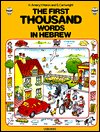
The First Thousand Words in Hebrew
By Heather Amery
This book is for everyone who is starting to learn Hebrew. By looking at the pictures, it will be easy to read and learn the words underneath each one. And seeing them in a scene where you would expect to find them will help you to remember them.
Description from Publisher
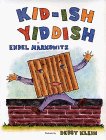
Kid-Ish Yiddish
By Endel Markowitz
Do you know the difference between Farmisht, Fartumelt,
Farblunjet, and Farpotchket? . . . readers of all ages will
delight in learning the subtle differences in Kid-ish Yiddish, a unique compilation
of Jewish humor, customs and superstitions in the new book by Endel Markowitz,
delightfully illustrated by Debby Klein. Kid-ish Yiddish, . . . transcribes the
wondrous expressions of Jewish humor into a series of beautiful illustrations
that derive from old Jewish beliefs and practices to those of modern contrasting usages.
Description from The Sunpost

Darkonim 1

Darkonim 2
DARKONIM series utilizes a structured approach to the teaching (and learning) of Hebrew. This approach is evident in both the development of grammatical patterns and the control over the amount of vocabulary. Only patterns already known , or intended to be taught (learned) during a given unit are used in dialogues, stories and exercises. In addition, the fact that various components continually re-appear in each unit makes the book "user friendly" as students become familiar with the various exercises and feel comfortable working with them.
Each book of DARKONIM has six units which describe content pertaining to Israel or to Jewish life.
Grammatically, this book provides the student with a multitude of exercises in functional and formal grammar developing gradually from Present Tense and Infinitive of the Paal and Piel patterns to all other tenses and patterns, as well as to many structural patterns such as question words, prepositions, negative forms, the Definite Article, syntax, etc.
Description from Publisher
Page 1 |
Page 2 |
Page 3 |
Page 4
Still can't find what you're looking for? Search Amazon.com's database directly.
©1999-2006
(NOTE: The following links have NOT been placed on the site by the website owners. We have no control over which ads are selected and are not responsible for their religious content.)
If this page came up without frames, Click here to see the complete website
Other Pages of Interest:
Introductory Hebrew Books
Page 1 |
Page 2 |
Page 3 |
Page 4
Easy Reader and Picture Books:
Jewish Children's Books (General) |
Jewish Board Books |
Biblical Stories for Children |
Jewish Holiday Books |
Jewish Family Cookbooks |
Folktales and Talmudic Stories for Children |
Jewish Life Books (Mitzvot, Keeping Kosher, etc.) |
Jewish Life Cycle Books |
Family Haggadahs |
Children's Prayerbooks |
Introductory Hebrew Books |
Jewish History and Historical Fiction Picture Books |
Israel Books
Middle School and YA Books:
Bar Mitzvah Books |
Jewish Fiction |
Historical Fiction |
Torah Study |
Prayer and Jewish Life Books |
Jewish Holidays |
Jewish Biographies |
Jewish History Books |
Holocaust Books for Teens |
Israel Books
Jewish Books for Children |
Bar Mitzvah Books |
Jewish Parenting Books |
Jewish Music for Children |
Jewish Videos |
Jewish Toys and Gifts |
Jewish Gift Baskets and Gourmet Food |
Jewish Jewelry |
Amazon.com Coupons, Promotions, and Sales
Other Pages of Interest:
Introductory Hebrew Books
Page 1 |
Page 2 |
Page 3 |
Page 4
Easy Reader and Picture Books:
Jewish Children's Books (General) |
Jewish Board Books |
Biblical Stories for Children |
Jewish Holiday Books |
Jewish Family Cookbooks |
Folktales and Talmudic Stories for Children |
Jewish Life Books (Mitzvot, Keeping Kosher, etc.) |
Jewish Life Cycle Books |
Family Haggadahs |
Children's Prayerbooks |
Introductory Hebrew Books |
Jewish History and Historical Fiction Picture Books |
Israel Books
Middle School and YA Books:
Bar Mitzvah Books |
Jewish Fiction |
Historical Fiction |
Torah Study |
Prayer and Jewish Life Books |
Jewish Holidays |
Jewish Biographies |
Jewish History Books |
Holocaust Books for Teens |
Israel Books
Jewish Books for Children |
Bar Mitzvah Books |
Jewish Parenting Books |
Jewish Music for Children |
Jewish Videos |
Jewish Toys and Gifts |
Jewish Gift Baskets and Gourmet Food |
Jewish Jewelry |
Amazon.com Coupons, Promotions, and Sales
Easy Reader and Picture Books:
Jewish Children's Books (General) | Jewish Board Books | Biblical Stories for Children | Jewish Holiday Books | Jewish Family Cookbooks | Folktales and Talmudic Stories for Children | Jewish Life Books (Mitzvot, Keeping Kosher, etc.) | Jewish Life Cycle Books | Family Haggadahs | Children's Prayerbooks | Introductory Hebrew Books | Jewish History and Historical Fiction Picture Books | Israel Books
Middle School and YA Books:
Bar Mitzvah Books | Jewish Fiction | Historical Fiction | Torah Study | Prayer and Jewish Life Books | Jewish Holidays | Jewish Biographies | Jewish History Books | Holocaust Books for Teens | Israel Books
Jewish Books for Children | Bar Mitzvah Books | Jewish Parenting Books | Jewish Music for Children | Jewish Videos | Jewish Toys and Gifts | Jewish Gift Baskets and Gourmet Food | Jewish Jewelry | Amazon.com Coupons, Promotions, and Sales
 Shirim K'Tanim-Hebrew Song Fest (VHS Video) |
With a wink here and a jig there genial Israeli TV star Uzi Chitman takes toddlers and young children on a musical tour of over 40 of Israel's best-loved children's songs. Accompanied by a handful of Israeli boys and girls, the singer/guitarist cavorts against a backdrop of colorful, simply sketched scenes depicted in each song.
Line dances and clapping games liven the action and little ones will join in the pantomime of songs like "Lakova Sheli" (My Hat Has...) or "Etsba'ot Li" (I Have Fingers). They'll also laugh at hearing their own favorites like "Old McDonald" sung with a Hebrew twist when Chitman and his chaverim (pals) visit the farm of "Dod (Uncle) Moshe." Adults can help the kids keep up with this fast-paced collection by reading the translations and transliterations that accompany most songs.
|
 Hebrew in Song By Ronit Ben-Arie & Sharon Alcalay (CD) |
Song List:
Hebrew in Song is a collection of 21 original songs composed by Ronit Ben-Arie; a teacher, composer and arts therapist, who specializes in teaching Hebrew through the arts . These songs are in Hebrew and English and introduce children to simple Hebrew words and phrases as a way to teach Hebrew vocabulary and grammar as well as provide information about Jewish celebrations and customs and the Jewish year. "Hebrew in Song" can be used to generate activities in movement, drama, educational games and art projects. The songs relate directly to topics from the child's life. Topics include Shabbat and holidays, custom greetings and activity directions, fruit, vegetables, colors, seasons, clothing and objects. The songs were written to be used in class, at home and at community celebrations. The CD features 21 songs at highest quality of recording, highly professional vocals and a variety of mostly live instruments orchestrated together. A 12-page booklet is included with the CD. The booklet contains the lyrics of the songs in Hebrew and transliteration in English. Album Description Searching for a fun way to teach Hebrew in the classroom and at home to young families? We have just what you're looking for, as we proudly introduce educator, composer, songwriter and Expressive Arts Therapist Ronit Ben-Arie and her playful new recording and songbook. A charismatic collection of 21 original children's songs especially designed to familiarize young people with the Jewish holidays and basic vocabulary words teaching about "…fruit, vegetables, colors, seasons, winter clothing and objects." The music comes to life with the beautiful vocal interpretations of Sharon Alcalay Leibovici, Lisa Segal, and Shelly Orbach. Songbook complete with Teacher's Guide including sheet music, transliteration of the lyrics, Hebrew text, as well as a dictionary of key words. Suggested educational activities also enclosed. Liven up the classroom with Bakita Sheli, Chagiga Bagan, Ma Basalat, Amen V'amen, B'yachad Im Yisrael, Yerushalayim, Kos Kiddush, and many more! |
 Renyi Picture Dictionary Hebrew By P. Renyi | |
Hebrew: A Language Course
|
This three-volume course is the ideal Hebrew program for English-speaking high school, college, and adult education students. The only entry requirement is the ability to recognize Hebrew letters and to read basic words. This course requires only one or two hours of class time each week. Features include:
I used this book when I was a kid and thought that it was the best Hebrew book that I had. I am now using it to teach my own students. It is a very great book because it does not assume that you have outside knowledge. The texts build on each other like you would hope that a language text would. The series is aimed at adults however I would recommend it for any age group. This book assumes that students aren't in an ulpan or other immersive environment, which is good because I'm not and most American students aren't. It takes it slowly with lots of exercises. The other thing I really like about this series is that it uses examples from Jewish culture, the Bible and other Jewish writings. It goes beyond teaching language to teach culture. Ora Band and Bella Bergman have shattered the rules of Hebrew instruction with this ground breaking work. The "Shelabim," in the vernacular, works with all sides of the brain to ensure total absorption of grammar, language and usage. One can use this text for young and older adults, teens and younger kids with equal ease. Students will come away from this work really having learned something. I used this text on a college level, and the students learned a great deal without feeling they had overly exerted themselves. I was Bar Mitzvah 37 years ago and had not studied since then. I wanted to be able to speak Hebrew, and to understand the Siddur. Studying with a tutor and using this book was a terrific start. It is entertaining and warm. While you learn, the stories in each unit will heighten your mood. Then you can go ahead to Level 2, and it get's better. I doubt that there is any better way to learn Hebrew for one who vaguely remembered the aleph-bet. |

Ta-Poo-Ach Means Apple |
Captioned illustrations introduce the letters of the Hebrew
alphabet and common Hebrew words, from ta-poo-ach
(apple) to ra-keh-vet (train)
|

The Jewish Kids' Hebrew-English Wordbook |
Here are the Hebrew words a Jewish kid needs to know...a book full of useful
Hebrew words and phrases. This book offers kids a new and enjoyable way
to learn Hebrew. Using full-color illustrations of such familiar scenes as a
summer camp, a synagogue, a kibbutz, and an Israeli town, award-winning
author Chaya Burstein takes children on a fun-filled tour of familiar American
and Israeli settings, teaching them about the Jewish holidays and customs.
Since each word is highlighted in English and Hebrew, with Hebrew transliterations, it's easy for young readers to recognize and absorb each new word. In addition, children will love searching for Kofee, the playful monkey, who hides within each page. The Jewish Kids' Hebrew-English Wordbook is great at home, where kids and their parents can learn together, or in the classroom. |

My First Hebrew Alphabet Book By Jennifer Lapine and Susan Lapine |
The perfect aleph-bet for ages three through seven. Big Hebrew
letters with English pronunciations are faced by sprightly
pictures of animals and objects illustrating their use. A
visual adventure!
|

Alef Bet : A Hebrew Primer By Abraham and Adaia Shumsky |
A phonetic approach,
Alef-Bet systematically introduces the letters and vowels of the
Hebrew alphabet, then words used in blessings, prayers, and discussions
of Jewish symbols, customs, and holidays. Includes photographs of
three-dimensional cutouts in full color.
|

The Aleph-Bet Story Book |
A JPS children's classic. These appealing stories bring life
and character to several letters of the Hebrew alphabet. Do
you know how Dalet helped Adam build his home? Do
you know how Vav assisted in the Exodus from Egypt?
|

Goodnight My Friend Aleph By Tova Mordechai |
A charming, delightfully illustrated book, designed to
lull your little one to sleep while teaching
Aleph- "Basics." As he says "goodnight" to all of his
friends - from Eliezer Avraham Esrog to Tanchum
Torah - he is introduced to the essential objects
in a Jewish child's life. Contains a glossary and
the "Shema" in Hebrew and English.
|

Perah Ha Shalom (Peace Flower, in Hebrew) By Ada Aharoni |
Peace Flower is a beautiful and inspiring story for the entire family, which can be read from the age of ten to a hundred and ten. It will delight young and old both for its exciting story, and its deep levels of symbolic and metaphorical truths relevant to our own times. It is an imaginative tale of fantastic adventures in space, to find the Peace Flower and bring it back to earth as it does not yet exist in our present.
Lee and Ronni, two brave children, face the terrible nuclear giant Nuki, who tries to stop them from bringing the magical peace flower to our earth. If they do, they will have the opportunity to put the symbolic nuclear dragon, Nuki, back into its box and end war forever. They travel the universe, past, present and future in a magical vehicle called, Muzi, guided by Petra, the smart and resourceful sister of Peter Pan. When Lee and Roni, at the suggestion of wise scientist Bayles, go on their dangerous and urgent mission to find the Peace Flower, which can only be found in Esperia, the Land of the Future, they symbolize our hope that the next generation will be able to create a better world beyond war. |

My First Words |
|

Renyi Picture Dictionary : Hebrew and English |
|

The Yiddish Alphabet Book |
Introduces the twenty-two basic letters of the Yiddish alphabet and words that demonstrate each letter's sound.
|

Alef is One: A Hebrew Alphabet and Counting Book By Katherine Janus Kahn |
From ONE (Alef) bright orange lion to 400 (Taf) rainbow-colored parrots,
this bestiary is sure to delight. With transliterations.
|

Let's Read Hebrew: The Aleph Bet for Our Days By Anna Parmet Koch |
|

The New Siddur Program for Hebrew and Heritage: Reading Readiness Book By Carol Levy |
An introduction to the alef bet at the pre-primer level. Pictures from our Jewish heritage illustrate each Hebrew letter, including:
102 colorful images teach the name of each letter and the sound it makes, while presenting a picture dictionary of practical vocabulary for beginning Hebrew students. Print writing practice reinforces the form of the letter. Visual and auditory discrimination exercises drill letter recognition. Reading Readiness is the ideal introduction to The New Siddur Program Primer. |

The New Siddur Program for Hebrew and Heritage: Primer By Pearl Tarnor and Ruby G. Strauss |
Each lesson--40 in all--focuses exclusively on a single letter or vowel, colorfully illustrating its sound and form. For example, the letter mem is introduced with mezuzah; het, with hallah.
In every chapter, students build upon what they've already learned. By the end of the book, students can read Hebrew--and they will have been introduced to over 200 prayer words. |

The New Siddur Program for Hebrew and Heritage: L'Hamshich: A Transitional Text |
This transitional text builds a bridge from the Primer to Book 1 of The New Siddur Program. It provides reading review, remediation, and vocabulary readiness, geared to prepare for Book 1.
|

The New Siddur Program for Hebrew and Heritage: Book One By Pearl and Norman Tarnor |
Your students already have a basic prayer vocabulary. Now they're ready to build a strong foundation for siddur study with a unique, lively combination of prayer materials, activities, and stories.
|

The New Siddur Program for Hebrew and Heritage: Book Two By Pearl and Norman Tarnor |
Students build on the skills they learned in Book 1 and continue on the path to siddur Hebrew mastery, with extra attention paid to comprehension of prayer words and concepts.
|

The New Siddur Program for Hebrew and Heritage: Book Three By Pearl and Norman Tarnor |
The unique format of Book 3 recognizes students' ability to work more directly and actively with prayer material than ever before.
Each lesson begins with a prayer. Reading exercises continue to promote siddur fluency, while grammar exercises bolster vocabulary comprehension with a strong emphasis on roots, suffixes, and prefixes. Each lesson concludes with a traditional story that illustrates the theme of the prayer. Stories include:
|

The New Siddur Program for Hebrew and Heritage: Book Four By Pearl and Norman Tarnor |
For schools requiring an additional year of study in The New Siddur Program, Book 4 builds upon the basic prayer literary students have already achieved. Their mastery of the Shabbat service is extended to the prayers we recite on the High Holidays and Passover. Readings from the Mahzor and the Haggadah introduce holiday concepts and key vocabulary.
Book 4 is divided into two units: the first presents selections from the High Holiday Mahzor; the second is built around the Passover Haggadah. Each chapter contains:
|

The Educational Director's Guide to Managing the New Siddur Program By Terry Kaye |
A comprehensive, hands-on guide to managing the best-selling Hebrew program in North America. Use this management guide to:
|

Choveret Hadikduk By Hilda Weil |
For students of Hebrew as a second language, with language patterns described in simple models. Extensively revised and expanded edition.
|
 The First Thousand Words in Hebrew By Heather Amery |
This book is for everyone who is starting to learn Hebrew. By looking at the pictures, it will be easy to read and learn the words underneath each one. And seeing them in a scene where you would expect to find them will help you to remember them.
|
 Kid-Ish Yiddish By Endel Markowitz |
Do you know the difference between Farmisht, Fartumelt,
Farblunjet, and Farpotchket? . . . readers of all ages will
delight in learning the subtle differences in Kid-ish Yiddish, a unique compilation
of Jewish humor, customs and superstitions in the new book by Endel Markowitz,
delightfully illustrated by Debby Klein. Kid-ish Yiddish, . . . transcribes the
wondrous expressions of Jewish humor into a series of beautiful illustrations
that derive from old Jewish beliefs and practices to those of modern contrasting usages.
|
 Darkonim 1  Darkonim 2 |
DARKONIM series utilizes a structured approach to the teaching (and learning) of Hebrew. This approach is evident in both the development of grammatical patterns and the control over the amount of vocabulary. Only patterns already known , or intended to be taught (learned) during a given unit are used in dialogues, stories and exercises. In addition, the fact that various components continually re-appear in each unit makes the book "user friendly" as students become familiar with the various exercises and feel comfortable working with them.
Each book of DARKONIM has six units which describe content pertaining to Israel or to Jewish life. Grammatically, this book provides the student with a multitude of exercises in functional and formal grammar developing gradually from Present Tense and Infinitive of the Paal and Piel patterns to all other tenses and patterns, as well as to many structural patterns such as question words, prepositions, negative forms, the Definite Article, syntax, etc. |